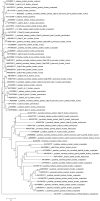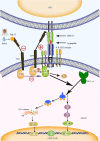Salp15, a Multifunctional Protein From Tick Saliva With Potential Pharmaceutical Effects
- PMID: 31998324
- PMCID: PMC6968165
- DOI: 10.3389/fimmu.2019.03067
Salp15, a Multifunctional Protein From Tick Saliva With Potential Pharmaceutical Effects
Abstract
Ixodes ticks are the main vectors for a number of zoonotic diseases, including Lyme disease. Ticks secrete saliva directly into a mammalian host while feeding on the host's blood. This action serves to modulate host immunity and coagulation, thus allowing ticks to attach and feed upon their host. One of the most extensively studied components of tick saliva is Salp15. Research has shown that this protein binds specifically to CD4 molecules on the surface of T lymphocytes, interferes with TCR-mediated signaling transduction, inhibits CD4+ T cell activation and proliferation, and impedes the secretion of interleukin 2 (IL-2). Salp15 also binds specifically to dendritic cell dendritic cell-specific intercellular adhesion molecule-3-grabbing non-integrin (DC-SIGN) to up-regulate the expression of CD73 in regulatory T cells. Collectively, these findings render this salivary protein a potential candidate for a range of therapeutic applications. Here, we discuss our current understanding of Salp15 and the mechanisms that might be used to treat disease.
Keywords: Borrelia burgdorferi; Salp15; T cell; immunomodulation; therapeutic effects; tick.
Copyright © 2020 Wen, Wang, Ji, Pan, Jian, Bi, Zhou, Luo, Chen, Li, Ding, Abi, Liu and Bao.
Figures


Similar articles
-
Salp15 binding to DC-SIGN inhibits cytokine expression by impairing both nucleosome remodeling and mRNA stabilization.PLoS Pathog. 2008 Feb 8;4(2):e31. doi: 10.1371/journal.ppat.0040031. PLoS Pathog. 2008. PMID: 18282094 Free PMC article.
-
Two novel Salp15-like immunosuppressant genes from salivary glands of Ixodes persulcatus Schulze tick.Insect Mol Biol. 2010 Jun 1;19(3):359-65. doi: 10.1111/j.1365-2583.2010.00994.x. Epub 2010 Feb 26. Insect Mol Biol. 2010. PMID: 20201978
-
Whole-Chain Tick Saliva Proteins Presented on Hepatitis B Virus Capsid-Like Particles Induce High-Titered Antibodies with Neutralizing Potential.PLoS One. 2015 Sep 9;10(9):e0136180. doi: 10.1371/journal.pone.0136180. eCollection 2015. PLoS One. 2015. PMID: 26352137 Free PMC article.
-
The immunosuppresive tick salivary protein, Salp15.Adv Exp Med Biol. 2009;666:121-31. doi: 10.1007/978-1-4419-1601-3_10. Adv Exp Med Biol. 2009. PMID: 20054980 Review.
-
Tick saliva: recent advances and implications for vector competence.Med Vet Entomol. 1997 Jul;11(3):277-85. doi: 10.1111/j.1365-2915.1997.tb00407.x. Med Vet Entomol. 1997. PMID: 9330260 Review.
Cited by
-
Prevention of tick-borne diseases: challenge to recent medicine.Biologia (Bratisl). 2022;77(6):1533-1554. doi: 10.1007/s11756-021-00966-9. Epub 2022 Mar 9. Biologia (Bratisl). 2022. PMID: 35283489 Free PMC article. Review.
-
Identification of Aedes aegypti salivary gland proteins interacting with human immune receptor proteins.PLoS Negl Trop Dis. 2022 Sep 7;16(9):e0010743. doi: 10.1371/journal.pntd.0010743. eCollection 2022 Sep. PLoS Negl Trop Dis. 2022. PMID: 36070318 Free PMC article.
-
Tick Salivary Compounds for Targeted Immunomodulatory Therapy.Front Immunol. 2020 Sep 23;11:583845. doi: 10.3389/fimmu.2020.583845. eCollection 2020. Front Immunol. 2020. PMID: 33072132 Free PMC article. Review.
-
Human Tick-Borne Diseases and Advances in Anti-Tick Vaccine Approaches: A Comprehensive Review.Vaccines (Basel). 2024 Jan 29;12(2):141. doi: 10.3390/vaccines12020141. Vaccines (Basel). 2024. PMID: 38400125 Free PMC article. Review.
-
Tick Saliva and Salivary Glands: What Do We Know So Far on Their Role in Arthropod Blood Feeding and Pathogen Transmission.Front Cell Infect Microbiol. 2022 Jan 19;11:816547. doi: 10.3389/fcimb.2021.816547. eCollection 2021. Front Cell Infect Microbiol. 2022. PMID: 35127563 Free PMC article. Review.
References
Publication types
MeSH terms
Substances
LinkOut - more resources
Full Text Sources
Research Materials

